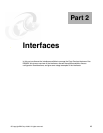8 IBM System Storage DS6000 Series: Copy Services with IBM System z
2.1 Introduction to the Copy Services structure
The Copy Services architecture for the IBM ESS 800 used a construct called a Copy Services
Domain
to manage Copy Services. The communications architecture for DS6000 and
DS8000 is noticeably different. Instead of a Copy Services Domain, we now use the concept
of
Storage Complexes.
You can perform Copy Services operations both within or between Storage Complexes. An
ESS 800 Copy Services Domain (at the correct firmware level) can, for management
purposes, appear to a DS6000 or DS8000 as an independent Storage Complex.
Now within a Storage Complex you will find management consoles, Storage Units, and in the
case of DS8000, Storage Facility Images. First, we define each of these constructs.
2.1.1 What is a management console?
A management console is a PC that is used to manage the devices within a Storage
Complex. In the case of the DS6000, it is a PC with a Windows operating system, onto which
the user has installed the DS Storage Manager Console software. This is usually referred to
as a Storage Management Console or SMC. In the case of the DS8000, it is a dedicated PC
that comes with a pre-installed Linux-based operating system and pre-installed management
software. The DS8000 console is called a Hardware Management Console (HMC).
In either case, the end-user interacts with the management console using either the Web
browser-based DS GUI or the Command-Line Interface (DS CLI). It is possible using the DS
GUI to manage Copy Services operations on multiple Storage Complexes.
2.1.2 What is a Storage Unit?
A Storage Unit is the physical storage device (including expansion enclosures) that you see
when you walk into the computer room. If you open a rack door and look at a DS6000 system
enclosure (a 1750-511 or 522) and all its attached expansion enclosures (1750-EX1 or EX2),
then you are looking at a single DS6000 Storage Unit. If you then look at a DS8000 sitting on
the floor (with any attached expansion racks), then you are looking at a DS8000 Storage Unit.
An example would be a 2107-922 or 932 with an attached 2107-9E2. Another example would
be a 2107-9A2 with an attached 2107-9AE. Each example would be a single DS8000 Storage
Unit.
2.1.3 What is a Storage Facility Image (SFI)?
The Storage Facility Image construct is different for the DS6000 and DS8000.
DS6000 SFI
For the DS6000, the SFI concept does not really apply. You could say that each DS6000
Storage Unit contains one SFI. However, in general a DS6000 is always referred to as simply
a Storage Unit. When using the DS CLI, there are separate commands to display a DS6000
Storage Unit or a DS6000 SFI. However, both will refer to the same device. Using the DS
GUI, you only work with the DS6000 Storage Unit. The GUI will not offer an option to select a
DS6000 SFI. In Example 2-1 we connect to a DS6000 Management Console using the DS
CLI. We issue the lssu command to display the DS6000 Storage Unit and the lssi command
to display the DS6000 Storage Facility Image. In each case we see the same serial number
and the same WWNN (World Wide Node name). The Storage Unit and the SFI are the same.


















